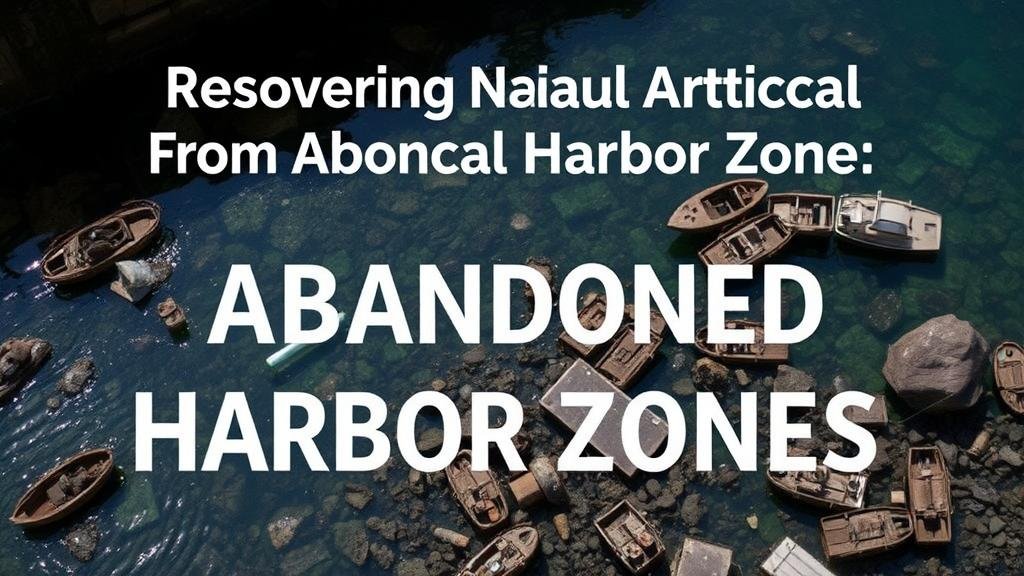Recovering Nautical Artifacts From Abandoned Harbor Zones
Recovering Nautical Artifacts From Abandoned Harbor Zones
Nautical artifacts, which encompass a wide array of objects such as shipwrecks, dock components, and various tools, hold immense historical and cultural significance. Abandoned harbor zones, often overlooked, serve as vital archaeological sites where these artifacts can be uncovered. This article delves into the methodologies, challenges, and implications of recovering nautical artifacts from such sites, providing a thorough understanding of this specialized field.
The Importance of Nautical Artifacts
Nautical artifacts provide invaluable insights into maritime history, trade practices, and cultural exchanges. e items often tell stories that written records cannot, offering a unique perspective on societal activities, shipbuilding techniques, and economic conditions during different eras. For example, the excavation of a 17th-century shipwreck off the coast of Spain revealed trade patterns between Europe and the Americas, leading to significant advancements in our understanding of transatlantic commerce.
The recovery of nautical artifacts from abandoned harbor zones employs various methodologies that can be categorized into non-intrusive and intrusive techniques.
- Remote Sensing: Technologies such as sonar mapping and magnetometry are employed to create detailed maps of underwater landscapes, helping archaeologists locate potential sites of interest without disturbing the seabed.
- Underwater Archaeology: Divers equipped with specialized tools carefully excavate selected areas following meticulous protocols to ensure the preservation and documentation of artifacts as they are recovered.
For example, the use of side-scan sonar at the site of the Titanic has enhanced our understanding of its final resting place, revealing scattered debris fields while allowing archaeologists to prioritize recovery efforts.
Challenges in Artifact Recovery
Recovering nautical artifacts is fraught with challenges that require careful consideration and strategic planning.
- Environmental Factors: The underwater environment presents challenges such as strong currents, visibility issues, and marine life that can hinder recovery efforts.
- Legal and Ethical Considerations: Jurisdictions regarding ownership, protection of heritage sites, and salvage rights can create complex legal landscapes that must be navigated.
A notable case is the recovery of artifacts from the USS Arizona, which is protected under the National Historic Preservation Act. Efforts to recover items from this site were carefully monitored to respect the sites significance as a war memorial.
Case Studies in Artifact Recovery
Several significant case studies illustrate the successful recovery of nautical artifacts from abandoned harbors:
- Boston Harbor: A series of expeditions in the 1990s uncovered a 19th-century shipwreck containing cargo items, which illuminated the trade routes and economic conditions of the time.
- Mary Rose: The recovery of this 16th-century warship in 1982 played a pivotal role in maritime archaeology, offering a glimpse into Tudor shipbuilding and naval warfare.
These case studies not only demonstrate successful recovery techniques but also highlight the significance of teamwork between government agencies, local communities, and international bodies in managing such projects.
Real-World Applications and Implications
The recovery of nautical artifacts has practical applications ranging from cultural tourism to educational initiatives. By showcasing recovered artifacts in museums or heritage centers, organizations can stimulate local economies and foster an appreciation for maritime history among the public.
According to the National Park Service, heritage tourism brings in over $2 billion annually within the United States, illustrating the economic potential of recovered artifacts. Also, educational programs based on the recovered artifacts can inform future generations about historical maritime practices, conservation efforts, and cultural heritage.
Actionable Takeaways
- Encourage local communities to engage in preservation efforts through volunteering and educational initiatives.
- Promote awareness of the legal frameworks governing artifact recovery in your region.
- Support museums and institutions that focus on the conservation and exhibition of nautical artifacts.
To wrap up, recovering nautical artifacts from abandoned harbor zones is a multidisciplinary endeavor that requires careful planning, respect for legalities, and appreciation for the artifacts historical significance. By employing advanced methodologies and addressing the myriad challenges, archaeologists can unlock the stories of the past, enriching our understanding of maritime history and cultural heritage.



